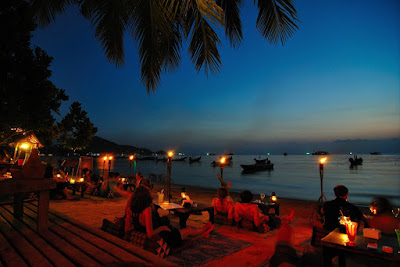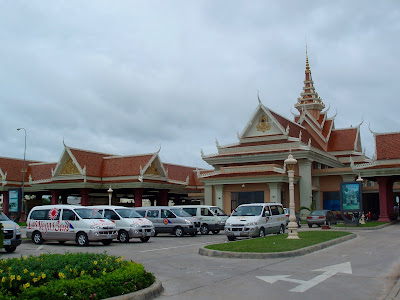Tailandia
Lado Oeste
 |
| Botes largos para turistas en Maya Bay |
La rutina me atrapó un poco y no había tenido – o no me había hecho – el tiempo de escribir en el blog. Sin embargo, ahora que ya me encuentro de vacaciones nuevamente, una de las primeras cosas que quise hacer fue dedicarme a redactar lo que fue la última parte de nuestro viaje por Tailandia, esta vez por las islas ubicadas en su lado oeste, como Phuket, Krabi y, cómo no, su isla más famosa, Koh Phi Phi.
Phuket
Phuket, o la Perla de Tailandia del Sur, como se le conoce debido a sus playas de arena blanca y agua tibia, es tan grande que no parece una isla. De hecho, sus 49 kilómetros de longitud hacen que sus visitantes se sientan como si no estuviesen rodeados por el mar.
Hasta hace poco, Phuket era un secreto compartido entre mochileros de diferentes lugares del mundo. Sin embargo, hoy en día se ha plagado de hoteles, tiendas comerciales y restaurantes, entre otros. Aun así, Phuket atrae a casi 3 millones de turistas cada año. Y vale la pena visitarla.
Hostal
Una vez en Phuket, nos alojamos en el hostal Balcony por 400 THB por persona. Sin lugar a dudas, es un hostal que recomendamos. Es limpio, cómodo, bien ubicado y, lo mejor, de una atmósfera muy grata. Las habitaciones son compartidas porque es un lugar para mochileros y, por ende, el ambiente es ideal para conocer a otros viajeros e intercambiar información.
El hostal está ubicado en Patong, uno de los sectores más visitados de la isla. Además, se encuentra a 10 minutos a pie de la playa del mismo nombre.
Songkran (Fiesta del Agua)
Ni idea teníamos de que cuando llegáramos a Phuket, nos iban a recibir en medio de un festival donde el agua era la protagonista principal.
El 13 de abril de cada año se celebra en todo el país la llegada del Año Nuevo Tailandés, que se extiende también a los días 14 y 15. Durante el festival, lugareños y turistas caminan por las calles de la ciudad con pistolas de agua en mano para empaparse unos a otros sin cesar.
Como consejo, recomendamos comprar bolsos a prueba de agua – los que pueden encontrar prácticamente en todos lados – para que sus pertenencias no se estropeen. Y, por supuesto, no se olviden de comprar una pistola de agua para salir a divertirse.
Malin Plaza
En la misma zona también encontrarán uno de los mejores mercados de comida de Phuket, Malin Plaza, famoso por sus bajos precios y diversidad de platos tailandeses. Si bien el mercado abre sus puertas oficialmente a las 13:00 hrs., ya desde temprano no es extraño ver a turistas visitando el lugar en búsqueda de un rico desayuno estilo tailandés.
 |
| Vendedor preparando Pad Thai para nosotros en Malin Plaza |
 |
| Uno de los tantos puestos de comida en Malin Plaza |
Además, en la parte de atrás del mercado, también hay puestos de artesanía y ropa que abren, en su mayoría, cuando cae la noche.
Patong Beach
Esta playa se encuentra a pocos minutos a pie desde la zona de alojamiento principal en Patong. Si bien no es paradisiaca como otras playas en Tailandia, pues cuenta con más comercio y, por ende, menos tranquilidad, resulta ideal para quienes quieran disfrutar de unas horas bajo el sol y luego darse una vuelta por las varias tiendas que ofrece el lugar a fin de comprar recuerdos para llevar de vuelta a casa.
 |
| Parapente en Patong Beach |
Con respecto a si la playa es apta para baño, diríamos que sí. Sin embargo, lo dejamos a su criterio. También es importante que sepan que, a ciertas horas, el agua se llena de variados tipos de medusas, por lo que aconsejamos tener mucha precaución y, así, evitar un mal rato.
Krabi
Krabi es otra de las maravillas que nos ofrece Tailandia. Pequeño y pintoresco, este lugar está majestuosamente situado entre impresionantes manglares naturales de piedra caliza que sobresalen a la vista de todos sus visitantes.
Desde Phuket, la forma más rápida de llegar a Krabi es vía bus. El trayecto es de aproximadamente 3 horas. Los lugares que visitamos en Krabi fueron los siguientes:
Railay Beach
Accesible sólo vía bote, esta península, que se divide en cuatro áreas principales, es el destino perfecto para todo tipo de turistas. Railay Beach es la playa más concurrida debido a su arena de tonos dorados y agua de agradable temperatura, así como a su ambiente relajado e ideal para disfrutar de unas cervezas bajo el sol. Además, en medio de la península existe una zona selvática que la convierte en el panorama perfecto para los amantes de actividades como el trekking y rock-climbing.
 |
| Camino a Railway Beach con más amigos mochileros |
 |
| Foto panorámica de Railay Beach |
Si se alojan en Pak Up Hostel, basta caminar un par de cuadras hacia el muelle de la ciudad para embarcarse en un pequeño bote con dirección a Railay Beach. El pasaje ida y vuelta es de 300 THB por persona.
Tonsai Beach
Junto con Railay, Tonsai Beach es otra de las playas de la península. Si bien es más pequeña en comparación a sus vecinas, goza de una tranquilidad envidiable. Además, a pocos metros de la orilla, hay una serie de hostales, bares y restaurantes a precios razonables para todo tipo de visitantes. La playa es además la mejor de las cuatro de la zona para practicar rock-climbing.
 |
| Tonsai Beach |
Para llegar a Tonsai Beach, hay dos maneras: la primera es caminar por el borde la playa desde Railay Beach, trayecto que toma aproximadamente 20-25 minutos. La segunda, internarse en la zona selvática que ofrece la península, trayecto que les tomará aproximadamente 45-50 minutos dependiendo de su paso. Nosotros elegimos la segunda y no nos arrepentimos. Sólo les recomendamos ponerse bastante repelente, o van a transformarse en comida para mosquitos andante.
Krabi Town Walking Street
Sin dudarlo, Krabi Town Walking Street – o Paseo Peatonal de la Ciudad de Krabi en español – es el evento de compras más importante de esta parte de Tailandia. Con sus orígenes remontándose a 2013, este mercado callejero les permite a sus visitantes apreciar más detalladamente la vida de Tailandia del sur así como descubrir a artesanos y artistas de la zona que viajan hasta este lugar a vender sus productos.
 |
| Krabi Town Walking Sreet. A lo lejos se aprecia el escenario. |
Además, no sólo encontrarán artesanía, sino que también diferentes tipos de comida típica tailandesa. El mercado también cuenta con un pequeño escenario en el que artistas de la zona deleitan al público son sus presentaciones.
Las puertas de Krabi Town Walking Street se encuentran abiertas al público todos los viernes, sábados y domingos de 17:00 a 22:00 hrs. Además, la entrada es liberada tanto para lugareños como para turistas.
Koh Phi Phi
Tras la filmación de la película La Playa en el 2000, las Islas Phi Phi se volvieron sumamente famosas a nivel mundial. Se dividen en dos islas principales, Koh Phi Phi Leh y Koh Phi Phi Don, siendo ésta última la más poblada de las dos – debido a su mayor tamaño - y en la que se alojan los turistas de todas partes del mundo. Sin embargo, son las playas de Koh Phi Phi Leh las más concurridas por los visitantes a este paraíso natural gracias a que, precisamente en este sector, se encuentra Maya Bay, locación exacta de la película hollywoodense protagonizada por Leonardo DiCaprio.
 |
| Alejandro y yo en Maya Bay |
 |
| Botes a lo largo de Maya Bay |
Además en Koh Phi Phi Don, si son amantes de los gatos, van a poder disfrutar de su presencia en todos lados. La isla está PLAGADA de estos animales, lo que me hace pensar que, si las autoridades no toman medidas para controlar la población felina, las cosas podrían escapárseles de las manos. De cualquiera manera, para mí que amo los gatos fue una maravilla compartir con ellos.
 |
| Variados gatos por las calles de Koh Phi Phi Let |
Para visitar las playas de Koh Phi Phi Leh, les recomendamos tomar un taxi boat. El precio va a depender de la cantidad de personas. En nuestro caso, pagamos 1.500 THB en total, es decir, 500 THB por persona. Además, les aconsejamos visitar Maya Bay en la tarde, puesto que si van en la mañana, la playa va a estar repleta de turistas.
El recorrido en taxi boat también incluye otras paradas, como Monkey Island - Isla de los Monos en español - y otras playas vecinas a Maya Bay donde uno puede nadar y disfrutar del agua transparente que nos ofrece Koh Phi Phi Let.
 |
| Familia de monos en Monkey Island |
 |
| Meg en nuestro bote mientras recorríamos Koh Phi Phi Leh |
Un detalle importante que deben saber es que para bajar a Maya Bay, hay que pagar 200 THB por persona. Les dije que las playas se habían vuelto famosas…
INFORMACIÓN ÚTIL
- Si se encuentran en una de las islas del lado este, es recomendable revisar los precios ofrecidos por la compañía Lomprayah para llegar a Phuket. Es una de las más serias y confiables en su rubro. En nuestro caso, salimos desde la isla de Koh Samui y el precio fue de aproximadamente 800 THB por persona. El proceso es fácil: se toma un ferry hasta Surat Thani y, desde esta ciudad, se toma un bus a Phuket. El trayecto en bus es de más o menos 6 horas. Recuerden que si los pasajes los compran en el mismo puerto de salida, entonces son más económicos. Si los compran a través de su hostal u otra compañía, son siempre un poco más costosos.
- Una vez en Phuket, recomendamos alojarse en el hostal Balcony. Tiene una excelente ubicación así como un ambiente ideal para conocer a otros viajeros. Además, cuenta con habitaciones limpias y ordenadas y, en el primer piso, hay un pequeño restaurant en el que se puede desayunar, almorzar y cenar.
- En Krabi, el hostal Pak Up es una excelente opción. Está ubicado cerca de los lugares más atractivos de la ciudad, como la playa Railay Beach y el paseo peatonal Krabi Town Walking Street.
- Por su extrema popularidad y reducido tamaño, el alojamiento en Koh Phi Phi se agota con rapidez. Por lo tanto, recomendamos reservar un hostal con varios días de anticipación. Por llegar tarde, nuestra experiencia donde nos quedamos no fue de las mejores.
- En Koh Phi Phi, les recomendamos también contratar los servicios de un taxi boat para recorrer las islas. No sólo van a pagar menos y tener un bote para ustedes solos, sino que también van a estar ayudando a un lugareño a trabajar.
Y eso es todo. Las próximas entradas serán sobre Malasia, Singapur e Indonesia. Los invito a seguir leyendo mi contenido y a enviarme sus comentarios y sugerencias.
B.









































